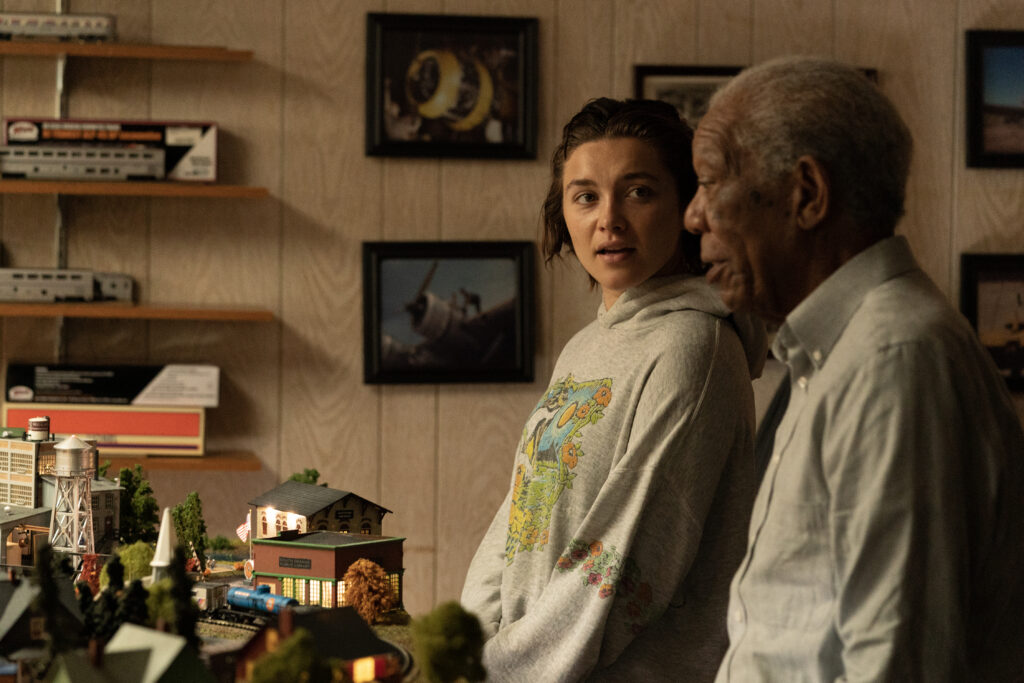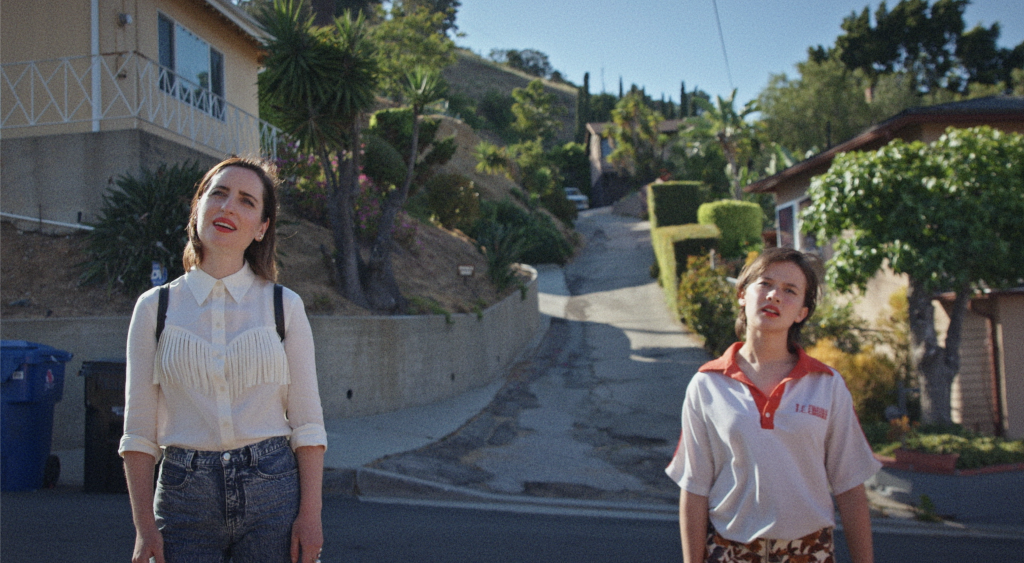March 22, 2023
by Carla Hay

Directed by Zach Braff
Culture Representation: Taking place in New Jersey, the dramatic film “A Good Person” features a racially diverse cast of characters (white and African American, with some Latinos and Asians) representing the working-class and middle-class.
Culture Clash: After driving in a tragic car accident that kills her fiancé’s sister and the sister’s husband, a former pharmaceutical sale representative goes through a breakup with the fiancé, gets addicted to opioids, and she forms an unlikely friendship with her ex-fiancé’s father.
Culture Audience: “A Good Person” will appeal primarily to people who are fans of the movie’s headliners and hard-hitting dramas about recovering from trauma.

“A Good Person” gets its title from the concept that a good person can do bad things. In the movie, as in real life, the issue often becomes about how much redemption and forgiveness can someone get (or derseve to get) after doing a lot of bad things. Florence Pugh, Morgan Freeman and Celeste O’Connor give standout performances in this searing drama about addiction and grief. An unrealistic “rescue” scene at a party almost ruins the movie. However, most of the film has emotional authenticity.
Written and directed by Zach Braff, “A Good Person” is at its best when it shows a myriad of complex emotions from several characters. It’s not always an easy film to watch, because the personal problems depicted in “A Good Person” might be “triggering” for people who have either experienced those struggles or have loved ones who’ve gone through the same struggles. It’s also a movie that tends to ramble with no clear direction on where it’s going. This meandering might seem like a flaw, but this narrative structure is meant to realistically portray the uncertainty of being in recovery from whatever could ruin someone’s life.
In “A Good Person” (which takes place and was filmed in New Jersey), the beginning of the movie shows an elaborate toy train set, which becomes a symbol in the movie for comfort from life’s woes. Viewers later find out that the train set belongs to a character named Daniel Adams (played by Freeman), who has his share of problems. Daniel says in a voiceover: “In the world of model train enthusiasts, there’s a level of order and symmetry. In life, of course, nothing is that neat and tidy.”
The next scene shows an engaged couple whose lives seem to be going (to use a train analogy) right on track and according to schedule. Pharmaceutical sales representative Allison “Allie” Johnson (played by Pugh) and her fiancé Nathan Adams (played by Chinaza Uche) are very much in love and have a healthy relationship. The first time that viewers see Allison and Nathan, they are gathered with friends for an engagement party at the couple’s home.
Allison, who is 25 years old, is vivacious and a little bit tipsy from drinking alcohol, as she sings and plays a piano. (Pugh, who is musically talented, wrote the original songs that she performs in the movie.) Nathan, who’s slightly older than Allison, is more laid-back and quieter than Allison. He gives a speech about how lucky he feels that she chose him to be her life partner. The atmosphere at the party is very warm-hearted and joyful. Two of the people at this party are Nathan’s older sister Molly (played by Nichelle Hines) and Molly’s husband Jesse (played by Toby Onwumere), who have a happy marriage.
After the party, Allison and Nathan are relaxing in bed. She’s feeling intoxicated by the marijuana gummy that he gave to her. And they talk a little bit about their future. Allison mainly sells Humira prescriptions for her job and is doing well, but she doesn’t want to be a pharmaceutical salesperson for the rest of her life. Nathan works in an unnamed office job. Allison and Nathan want to save enough money so they can afford to move from New Jersey and live in New York City.
One day, Allison, Molly and Jesse are driving on the New Jersey Turnpike to New York City for a day trip. They are in Allison’s car, and Allison is driving. The plan is that they will go to the city so that Allison can try on some wedding dresses. And then, they will see a Broadway show. Allison looks at her phone while driving. It turns out to be a tragic decision, because by taking her eyes briefly off of the road in front of her, she crashes into road repair truck.
Allison wakes up with serious but not critical injuries in a hospital. And then, she is told the bad news that Molly and Jesse did not survive the car crash. Nathan is the one who tells her. At first, Allison is in denial. And then, when the harsh reality sets in, it’s easy to see that Allison is going to feel tremendous guilt for a very long time.
The movie then fast-forwards to one year later. Allison and Nathan have broken up. Allison is now living with her divorced mother Diane (played by Molly Shannon) in a suburban New Jersey house in a middle-class neighborhood. Diane works in a retail store, but her job barely pays the bills for her and Allison. It doesn’t help that Diane and Allison are both struggling with addictions.
Allison is addicted to opioids, especially OxyContin, which she was prescribed during her physical recovery from the car accident. Diane is an alcoholic and pill addict. Unlike Allison, Diane (who guzzles wine and hoards Xanax) is a functioning addict who can hold a job. Allison has not gone back to work since the car accident. In addition to her addiction problems, Allison has depression that so far is untreated.
One day, Allison is watching an instructional video on YouTube on how people can cut their own hair. She impulsively decides to cut her long hair into a shaggy bob. Diane isn’t impressed and starts to nag Allison about this new haircut.
It turns into an argument with Diane scolding Allison about Allison’s addiction. “You’re such a hypocrite!” yells Allison. “Do you think I don’t notice how much Xanax you take?” The movie has several more scenes of these mother-daughter conflicts (some of them gut-wrenching), where Allison and Diane clash with each other over their addictions and other personal problems.
Meanwhile, viewers eventually find out if it was Nathan or Allison who ended their romance. Nathan and Allison have not kept in touch with each other since their breakup. However, Allison still checks Nathan’s social media and is dismayed to find out that he has a new girlfriend named Joelle (played by Sydney Morton). It sends Allison spiraling into wanting to numb herself with more OxyContin, but her prescription has run out, and she resorts to desperate measures.
“A Good Person” has some very well-acted scenes portraying the degradation and self-desctruction that comes with drug addiction. One of the most effective scenes is when Allison, who is broke and anxious to get high on opioids, walks into a bar in the middle of the day and sees two men who were her classmates in high school. Their names are Mark (played by Alex Wolff) and Diego (played by Brian Rojas), and they are drug addicts too.
The conversation between Allison, Mark and Diego reveals the contrasts between who Allison was back in high school (an elitist overachiever) and who she is now. Allison not only wants Mark and Diego to pay for her drinks, but she also asks them for help in scoring drugs that she can’t pay for either. It leads to a humiliating experience for Allison when Mark and Diego see that the power dynamics between them have flipped. Allison was a snob who wouldn’t give them the time of day in high school, but now Mark and Diego have the upper hand and want to use it to their advantage.
Allison has more than one “rock bottom” moment. She eventually seeks help by getting group counseling for her addiction. She goes to an Alcoholics/Addicts Anonymous meeting, where Allison sees someone she doesn’t want to see: Nathan’s father Daniel, who is a recovering alcoholic. As shown in the trailer for “A Good Person,” Allison’s first reaction is to want to leave the meeting, but Daniel asks her to stay, and she reluctantly agrees.
Daniel is a Vietnam War veteran and a retired New Jersey police officer. And he has been estranged for years from Nathan, for reasons that are revealed later in the movie. Molly and Jesse had a daughter named Ryan (played by O’Connor), who is now 16 years old. After the deaths of her parents, Ryan was put in the custody of her grandfather Daniel, who is struggling to raise this rebellious teen.
It’s mentioned several times in the movie that Ryan used to be a “good kid,” but she has been acting out in negative ways since the deaths of her parents. She’s been skipping classes and getting lower grades. She’s been physically fighting with one of her soccer teammates who bullies her because she’s an orphan. And she’s been dating a 20-year-old named Quinn (played by Ignacio Diaz-Silverio), who gets caught in bed with Ryan when Daniel seems them together in Daniel’s home. (Quinn says Ryan told him that she was 18 when the met, but he still keeps dating her after he finds out her real age.)
The unlikely friendship that develops between Daniel and Allison somewhat catches them off guard. It’s so unexpected and something that has never happened to them before, they don’t really know how to handle it at first and try to keep it a secret. “A Good Person” shows that Allison and Daniel actually have something else in common besides addiction problems: Allison and Daniel are also consumed with guilt for things they’ve done that have damaged other people.
“A Good Person” gets a little messy when it tries to weave together the issues that Allison has with her mother Diane and the issues that Allison has that result from her friendship with Daniel. Ryan eventually finds out about the friendship, which leads to more complications. However, life for these characters is messy. “A Good Person” tries to do a little too much with this mess, including going off on tangents about Ryan’s life, but the basic elements and intentions of the narrative remain clear.
Pugh does a masterful job at conveying the ups, downs and everything in between of someone who’s struggling to put her life back together while drowning in an emotional cesspool of self-loathing and suicidal thoughts. Freeman and O’Connor also have some well-acted scenes portraying how their respective characters are processing their grief. Shannon gives a convincing performance as someone who has to come to terms with her own problems before she can effectively help anyone else. Zoe Lister-Jones has a small but meaningful supporting role as Simone, a married mother from the Alcoholics/Addicts Anonymous group who agrees to be Allison’s sponsor.
There’s no denying that the performances from the principal cast members are the main reasons to watch this sometimes gritty, sometimes sentimental movie. “A Good Person” isn’t preachy, but it does show the importance of having a positive support system when life can get rough. The movie has some raw emotions that will hit a lot of viewers’ nerves. And this rawness might rub some people the wrong way, especially for viewers who want a formulaic and safe conclusion. However, if people want to see a memorable story about human connections, “A Good Person” is a worthy choice that comes with some flaws, just like real life.
Metro Goldwyn Mayer Pictures will release “A Good Person” in select U.S. cinemas on March 24, 2023.




